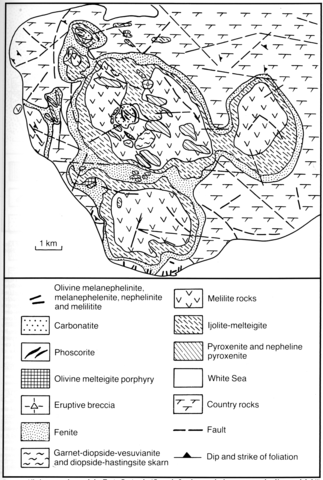stripes
The alkaline complex of the Turiy Peninsula consists of several intrusions of subvolcanic type and associated dykes and veins. The largest massifs of the complex - Central with an area of 28 km2, Southern (13 km2) and Kuznavolokskii (15 km2) - are separate intrusive bodies of complex form. Their shapes were determined by the block structures and complicated tectonics of the enclosing rocks at the time of intrusion. The intrusions are composed, from the oldest to the youngest rocks, of (1) ultramafic rocks (olivinite and clinopyroxenite), (2) feldspathoidal mafic rocks (melteigite, ijolite and ijolite-urtite), (3) melilite-bearing rocks (okaite, uncompahgrite, melilitolite and turjaite), (4) eruptive breccia of ijolite porphyry, (5) phoscorite and carbonatite and (6) dyke rocks. The intrusions have complicated zonal structures which indicate that initial single intrusive bodies were emplaced which were subsequently transformed into confocal intrusions with central stocks of carbonatite and phoscorite. With the emplacement of each successive phase there was associated intense alteration of the earlier rocks - nephelinisation, melilitisation, growth of garnet and mica and carbonatization - with multistage fenitisation of the enclosing granodiorites and Tersk sandstones. The principal minerals of the olivinites and pyroxenites are olivine, diopside-augite and titanomagnetite with subordinate nepheline, melanite, perovskite, titanite, apatite, amphibole, wollastonite, phlogopite, cancrinite and calcite. The melteigites, ijolites and urtites comprise nepheline, aegirine-augite, titanomagnetite and melanite with lesser amounts of perovskite, titanite, apatite, phlogopite, amphibole, sodalite, cancrinite and calcite. The predominant melilite-bearing rocks are turjaites and uncompahgrites, with melilitolites common but okaites rare. These rocks consist of melilite, nepheline and phlogopite with subordinate titanomagnetite, perovskite, apatite, diopside, olivine, schorlomite, amphibole, vesuvianite, sodalite and calcite. The petrogenesis of the turjaites is considered by Ronenson et al. (1981) who give whole rock and mineral chemical data. Among the carbonatites are calcitic, calcite-dolomitic and dolomitic types with ore phoscorites less abundant. The rock-forming minerals of the calcite carbonatites are calcite, forsterite and monticellite with accessory phlogopite, diopside, apatite, magnetite, serpentine, clinohumite, ilmenite, pyrite and baddeleyite. The calcite-dolomite and dolomite carbonatites consist of calcite and dolomite with subordinate pyrite, galena, sphalerite, tetraferriphlogopite, fluorite, magnetite and amphibole. The phoscorites of the Turiy Peninsula are much enriched either in apatite (5-15%) or in magnetite (up to 50-70%) with calcite (10-50%); minor minerals include forsterite, diopside, aegirine, hastingsite, actinolite, phlogopite and tetraferriphlogopite. Bulakh and Ivannikov (1984) emphasise the principal phoscorite associations of phlogopite-apatite-forsterite, forsterite-magnetite-calcite and apatite-magnetite-forsterite. The Central and Southern massifs are intersected by dykes of alkaline lamprophyres and in the northwestern part of the Southern massif there is a neck of olivine melteigite porphyry. Among the dyke rocks there are three groups. Group 1 includes altered picrites, monchiquites, alnoites, melilitites and carbonatites with evidence for explosive emplacement and also intense fenitisation. They are older than the central intrusions. Group 2 consists of rocks which are comagmatic with the large Turiy intrusive complexes. They include micromelteigite, olivine melteigite porphyry, turjaite, nephelinite and noseanite. They are associated with monomineralic veins in fenites and with carbonate rock veins, which form complicated dyke and vein systems. The third group, emplaced after consolidation of the principal alkaline intrusions, comprises, in order of decreasing age, monchiquite, olivine and olivine-melilite melanephelinte, melanephelinite, augitite, melilitite, nepheline melilitite and melilite nephelinite and calcite carbonatite. Among the carbonatites calcitic varieties with phlogopite, diopside and aegirine are the most prevalent; less common are melilite-bearing varieties, monomineralic calcite and dolomite types and dolomite-calcite carbonatites. Among hydrothermal veins there are apatite-aegirine, pyrhottite-aegirine-apatite, aegirine-anorthoclase with labuntsovite and strontianite, anorthoclase-wollastonite with eudialyte, quartz-albite-anorthoclase with arfvedsonite, narsarsukite and labuntsovite and quartz-calcite-fluorite with anatase. A detailed discussion of the carbonatites is given by Samoilov and Afanas'yev (1980) who give numerous analyses of rocks and many rock-forming minerals as well as estimates of temperatures of formation of carbonatites and associated quartz-bearing rocks.
BULAKH, A.G. and IVANNIKOV, V.V. 1984. Problems of mineralogy and carbonatite petrology. Leningradskii Gosudarstvennyi Universitet, Leningrad. 242 pp.
*KRAMM, U., KOGARKO, L.N., KONONOVA, V.A. and VARTIAINEN, H. 1993. The Kola alkaline province of the CIS and Finland: precise Rb-Sr ages define 380-360 Ma age range for all magmatism. Lithos, 30: 33-44.
KUKHARENKO, A.A., ORLOVA, M.P., BULAKH, A.G., BAGDASAROV, E.A., RIMSKAYA-KORSAKOVA, O.M., NEPHEDOV, E.I., IL'INSKII, G.A., SERGEEV, A.S. and ABAKUMOVA, N.B. 1965. The Caledonian complex of ultrabasic alkaline rocks and carbonatites of the Kola peninsula and north Karelia. Nedra, Moscow. 772 pp.
*RONENSON, B.M., AFANAS'YEV, B.V. and LEVIN, V.Ya. 1981. Turjaite paragenesis of Tur'ya Peninsula. International Geology Review 23: 535-43.
*SAMOILOV, V.S. and AFANAS'YEV, B.V. 1980. New data on the carbonatites of the alkaline-ultrabasic complex of Turiy Peninsula. International Geology Review, 22: 39-50.
SHURKIN, K.A. 1959. On Palaeozoic pseudo-conglomerates of North Karelia and the Kola peninsula. Doklady Akademii Nauk SSSR, 125: 1329-32.

